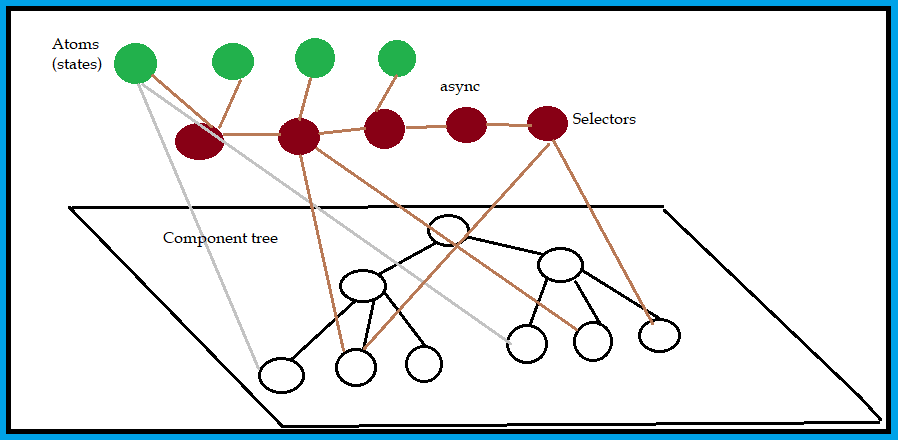The Evolving Landscape of React State Management
In the dynamic world of front-end development, managing application state remains a central challenge, especially as React applications grow in complexity. For years, developers navigated this challenge with solutions like prop-drilling or comprehensive libraries such as Redux. While powerful, these approaches often introduced boilerplate and a steep learning curve. The latest trends, or Recoil News, point towards a paradigm shift: a move towards more granular, atomic state management that feels intuitive and deeply integrated with React’s own principles. This is where Recoil, an experimental state management library from Meta, enters the conversation.
Recoil offers a minimalistic and Reactish API that leverages hooks and embraces the concept of a “graph” of state. Instead of a single, monolithic store, state is broken down into independent, subscribable units called “atoms.” Components can subscribe only to the specific pieces of state they need, leading to more precise re-renders and better performance. This article provides a comprehensive technical guide to Recoil, exploring its core concepts, practical implementations, advanced patterns, and its place in the modern ecosystem alongside giants like Redux News and nimble alternatives like Zustand News and Jotai News.
Core Concepts: Understanding Atoms and Selectors
Recoil’s elegance lies in its simplicity. It introduces two fundamental concepts—Atoms and Selectors—that form the backbone of your application’s state graph. To get started, you must first wrap your application’s root with the RecoilRoot provider, which makes the state available to all child components.
// index.js or App.js
import React from 'react';
import ReactDOM from 'react-dom/client';
import { RecoilRoot } from 'recoil';
import App from './App';
const root = ReactDOM.createRoot(document.getElementById('root'));
root.render(
<React.StrictMode>
<RecoilRoot>
<App />
</RecoilRoot>
</React.StrictMode>
);Atoms: The Atomic Units of State
An atom represents a single, subscribable piece of state. Think of it as a super-powered version of React’s useState, but with the ability to be shared among multiple components without prop-drilling. When an atom’s value changes, every component subscribed to it will re-render with the new value. Defining an atom is straightforward: you provide a unique key and a default value.
// src/state/userState.js
import { atom } from 'recoil';
export const userAuthState = atom({
key: 'userAuthState', // must be unique
default: {
isLoggedIn: false,
username: null,
token: null,
},
});
export const themeModeState = atom({
key: 'themeModeState',
default: 'light', // 'light' or 'dark'
});Selectors: The Power of Derived State
Selectors are the workhorses of Recoil. They represent “derived state”—a pure function that computes a value based on the state of one or more atoms or even other selectors. Recoil automatically tracks dependencies and caches (memoizes) the result. If none of the underlying dependencies change, the selector returns the cached value without re-executing its logic. This is incredibly efficient for calculating values, filtering lists, or performing complex transformations.
For example, we can create a selector that derives a welcome message based on the userAuthState atom.

// src/state/userState.js
import { selector } from 'recoil';
import { userAuthState } from './userState';
export const userWelcomeMessageState = selector({
key: 'userWelcomeMessageState',
get: ({ get }) => {
const auth = get(userAuthState);
if (auth.isLoggedIn) {
return `Welcome back, ${auth.username}!`;
}
return 'Welcome! Please log in.';
},
});Practical Implementation in React Components
Once your atoms and selectors are defined, interacting with them inside your React components is seamless thanks to a set of intuitive hooks. These hooks allow components to read, write, or both read and write to your Recoil state, ensuring that components only re-render when necessary.
Reading and Writing State with Hooks
Recoil provides three primary hooks for component interaction:
useRecoilValue(state): Subscribes the component to the state and returns its value. Use this when a component only needs to read the state.useSetRecoilState(state): Returns a setter function to update the state’s value. Use this for components that only write to state, preventing them from re-rendering when the value changes.useRecoilState(state): The most common hook, it behaves exactly likeuseState, returning a tuple of[value, setValue].
Here’s how you might build a simple theme toggler and a component that displays the welcome message from our selector.
// src/components/ThemeToggler.js
import React from 'react';
import { useRecoilState } from 'recoil';
import { themeModeState } from '../state/userState';
function ThemeToggler() {
const [theme, setTheme] = useRecoilState(themeModeState);
const toggleTheme = () => {
setTheme((prevTheme) => (prevTheme === 'light' ? 'dark' : 'light'));
};
return (
<button onClick={toggleTheme}>
Switch to {theme === 'light' ? 'Dark' : 'Light'} Mode
</button>
);
}
// src/components/Header.js
import React from 'react';
import { useRecoilValue } from 'recoil';
import { userWelcomeMessageState } from '../state/userState';
function Header() {
const welcomeMessage = useRecoilValue(userWelcomeMessageState);
return <h1>{welcomeMessage}</h1>;
}Handling Asynchronicity with Selectors
One of Recoil’s standout features is its first-class support for asynchronous operations directly within selectors. A selector’s get function can be asynchronous, returning a Promise. Recoil manages the pending state for you, integrating perfectly with React Suspense for loading states and Error Boundaries for handling failures. This pattern keeps your data-fetching logic clean, declarative, and co-located with your state definitions, a clear advantage over scattering useEffect hooks throughout your components. This is a key area where Recoil News often outshines older patterns seen in the Redux News cycle.
Let’s create a selector to fetch user data from an API based on a user ID atom.
import { atom, selector } from 'recoil';
export const currentUserIDState = atom({
key: 'currentUserIDState',
default: 1,
});
export const currentUserDataQuery = selector({
key: 'currentUserDataQuery',
get: async ({ get }) => {
const userID = get(currentUserIDState);
const response = await fetch(`https://jsonplaceholder.typicode.com/users/${userID}`);
if (!response.ok) {
throw new Error('Failed to fetch user data.');
}
const data = await response.json();
return data;
},
});
// In your component:
function UserProfile() {
const userData = useRecoilValue(currentUserDataQuery);
return (
<div>
<h2>{userData.name}</h2>
<p>Email: {userData.email}</p>
<p>Website: {userData.website}</p>
</div>
);
}
// In your App component, wrap UserProfile with Suspense
function App() {
return (
<React.Suspense fallback={<div>Loading user...</div>}>
<UserProfile />
</React.Suspense>
);
}Advanced Techniques and Ecosystem Integration
As your application scales, you’ll encounter more complex state management scenarios. Recoil provides powerful utilities like `atomFamily` and `selectorFamily` to handle dynamic and parameterized state, while the broader ecosystem offers solutions for persistence and debugging.

Managing Dynamic State with `atomFamily`
A common challenge is managing state for a collection of items, such as a to-do list where each item has its own state (e.g., completed status). Creating a separate atom for each item manually is impractical. `atomFamily` solves this by providing a factory function that creates a unique atom for each unique parameter passed to it. This is a powerful pattern for building scalable UIs in frameworks like Next.js News or Remix News.
import { atomFamily } from 'recoil';
// Creates a unique atom for each to-do item ID
export const todoItemState = atomFamily({
key: 'todoItemState',
default: (id) => ({ id, text: `Task ${id}`, isComplete: false }),
});
// In a component for a single to-do item:
function TodoItem({ itemID }) {
const [item, setItem] = useRecoilState(todoItemState(itemID));
const toggleCompletion = () => {
setItem({ ...item, isComplete: !item.isComplete });
};
return (
<div>
<span style={{ textDecoration: item.isComplete ? 'line-through' : 'none' }}>
{item.text}
</span>
<input
type="checkbox"
checked={item.isComplete}
onChange={toggleCompletion}
/>
</div>
);
}State Persistence and Tooling
By default, Recoil state is ephemeral and resets on page refresh. For persistence, the community has developed libraries like `recoil-persist`. It allows you to easily sync your atoms with `localStorage` or `sessionStorage` with minimal configuration, making it trivial to save user preferences or session data. When it comes to testing, Recoil’s hook-based nature makes it fully compatible with modern tools like React Testing Library News and Jest News, allowing you to test components in isolation by wrapping them in a `RecoilRoot` within your tests.
Best Practices and The Modern Landscape
To use Recoil effectively, it’s important to follow best practices and understand its place in the wider ecosystem, especially when considering tools like React Query News or Apollo Client News for server state.

Structuring and Optimizing State
- Co-location: Keep your atoms and selectors in a dedicated
statedirectory, often organized by feature or domain. This improves maintainability. - Granularity: Prefer smaller, more granular atoms over large, monolithic ones. This ensures that components only re-render when the specific data they care about changes.
- Use Selectors for Derived Data: Avoid storing computed values in state. Let selectors handle derivations to leverage memoization and keep your state minimal and normalized.
- Use `useRecoilCallback` for Performance: For event handlers or operations that need to access Recoil state without subscribing to it, the
useRecoilCallbackhook is an excellent optimization tool.
Recoil vs. The Competition
The state management landscape is rich with options. While Recoil is a fantastic choice, it’s crucial to know the alternatives.
- Redux: Still a powerful choice for large-scale applications, especially with Redux Toolkit, which significantly reduces boilerplate. Its mature ecosystem and strict data flow are major draws.
- Zustand & Jotai: These libraries are Recoil’s closest philosophical relatives. Both offer minimalist, hook-based APIs for atomic state. Zustand News is known for its simplicity and flexibility outside of React, while Jotai News offers an API that is remarkably similar to Recoil’s atoms but without the need for unique keys.
- React Query & SWR: It’s important to note that Recoil is primarily for client state. For server state (caching, re-fetching, and mutating API data), libraries like React Query News are often a better fit. The best architecture often involves using both: React Query for server cache and Recoil for global UI state like themes, modals, and user authentication status.
Conclusion: The Future of State in React
Recoil represents a significant step forward in React state management. Its atomic approach, deep integration with React’s concurrent features, and elegant handling of derived and asynchronous state make it a compelling choice for new projects. By providing a mental model that aligns closely with React itself, it reduces cognitive overhead and empowers developers to build complex, performant applications with greater ease and clarity.
While still officially “experimental,” Recoil is stable, well-supported by a growing community, and used in production at Meta. As you embark on your next project, whether it’s a simple app or a large-scale system using Vite News or Next.js News, consider giving Recoil a try. Its developer experience and performance benefits might just make it your new go-to solution for managing state in the ever-evolving React ecosystem.












